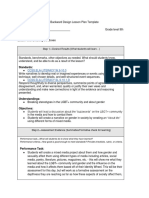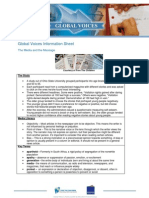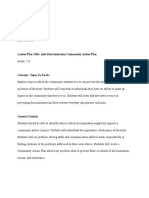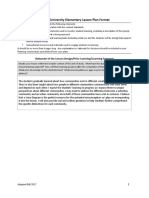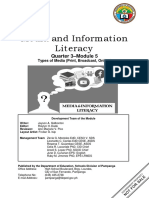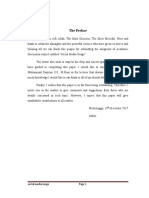0 ratings0% found this document useful (0 votes)
42 viewsB2 UNIT 10 Culture Teacher's Notes
B2 UNIT 10 Culture Teacher's Notes
Uploaded by
dima khrushcevThis document provides teaching notes for a lesson on open journalism and online news. The lesson introduces key vocabulary like engagement, influence, and input. Students will discuss where they find news online and read about open versus closed journalism. They will then work in groups to compare how the same news story was covered in three different countries, analyzing the role of public comments and input. The goal is for students to understand different cultural approaches to journalism and civic participation.
Copyright:
© All Rights Reserved
Available Formats
Download as PDF, TXT or read online from Scribd
B2 UNIT 10 Culture Teacher's Notes
B2 UNIT 10 Culture Teacher's Notes
Uploaded by
dima khrushcev0 ratings0% found this document useful (0 votes)
42 views1 pageThis document provides teaching notes for a lesson on open journalism and online news. The lesson introduces key vocabulary like engagement, influence, and input. Students will discuss where they find news online and read about open versus closed journalism. They will then work in groups to compare how the same news story was covered in three different countries, analyzing the role of public comments and input. The goal is for students to understand different cultural approaches to journalism and civic participation.
Copyright
© © All Rights Reserved
Available Formats
PDF, TXT or read online from Scribd
Share this document
Did you find this document useful?
Is this content inappropriate?
This document provides teaching notes for a lesson on open journalism and online news. The lesson introduces key vocabulary like engagement, influence, and input. Students will discuss where they find news online and read about open versus closed journalism. They will then work in groups to compare how the same news story was covered in three different countries, analyzing the role of public comments and input. The goal is for students to understand different cultural approaches to journalism and civic participation.
Copyright:
© All Rights Reserved
Available Formats
Download as PDF, TXT or read online from Scribd
Download as pdf or txt
0 ratings0% found this document useful (0 votes)
42 views1 pageB2 UNIT 10 Culture Teacher's Notes
B2 UNIT 10 Culture Teacher's Notes
Uploaded by
dima khrushcevThis document provides teaching notes for a lesson on open journalism and online news. The lesson introduces key vocabulary like engagement, influence, and input. Students will discuss where they find news online and read about open versus closed journalism. They will then work in groups to compare how the same news story was covered in three different countries, analyzing the role of public comments and input. The goal is for students to understand different cultural approaches to journalism and civic participation.
Copyright:
© All Rights Reserved
Available Formats
Download as PDF, TXT or read online from Scribd
Download as pdf or txt
You are on page 1of 1
Culture teacher’s notes B2 Unit
News online
LEARNING ■ I can learn about open journalism and online news around the world and make connections with my
OUTCOMES own culture.
■ I can discuss open journalism and online news and understand my own cultural identity.
■ I can make comparisons between cultures and use my own beliefs and values to improve my cultural
knowledge.
A VOCABULARY FOCUS Answers
1 people to give their input, to contribute, participate
engagement [n]: the feeling of being involved in a
and to shape and influence the news
particular activity
2 online newspapers, magazines, social media
influence [v]: to affect the way that someone thinks or
3 via social media, via comments, shares
behaves, or to affect the way that something happens
4 two-thirds are from outside the UK
input [n]: help in the form of ideas, advice or
information, used in a process or in making a decision 5 by reading comments, writing comments, sharing
articles, writing articles, breaking news via social media
instantaneously [adv]: immediately
6 USA Today, The New York Times, Washington Post
shifting [adj]: shifting things such as standards or
relationships are always changing 7 France
8 No, people can comment directly onto some articles
WARMER within online newspapers.
Ask students about social media and the news.
Write some of these questions on the board: Where Gateway to culture
can we find the news online? Where/How can you 3a Put students in pairs to discuss and answer the
find out what other people think about different questions. Elicit ideas and thoughts from the class.
news stories? Do you like to read other people's
comments? Where do they tend to be in the world? Answers
Do you comment on the news? How easy is it to Students' own answers
share the news? Have a class discussion to find out
students' answers to the questions. PROJECT
3b Explain to students that they are going to work in small
1 Ask students to look at the infographic and discuss groups of three or four to prepare a project on a news
the information with their partner. Elicit thoughts from story and how it has been covered in three different
students, then ask them to answer the question. countries. One will be their country, and a further two
in countries of their choice that covered the same
2a Students read the article about open journalism and story. They will make comparisons between the way
online news and answer the question. the journalist(s) covered the story and how/if open
Answers journalism was used in some way. Encourage students
closed journalism – a complete and finished article to discuss the points and questions given and any other
written by a journalist areas they find of interest.
open journalism – an article that may have been written For Step 1, they can choose an international news story,
by the journalist and is then also open for comment on or you could write a selection of some international
by its readers headlines on pieces of paper to help and ask groups to
pick one from a box. For Step 2, they will need Internet
2b Students read the article again and complete the access to do their research, and this can either be done
sentences. Have them check in pairs before checking as in class or at home. Students can share their findings
a whole class. with their group in the next class.
Answers 3c Students use their notes to make a presentation
1 online 2 increase 3 leading 4 intention comparing the three countries' use of open journalism
5 anywhere 6 Breaking 7 accessed for the same story. Encourage students to discuss
what differences they found, and whether one
2c Have students answer the questions according to the country used open journalism more than another.
article. Check their answers in small groups before Make comparisons between the role of the public in
answering in open class. sharing and commenting on the story in the different
countries.
This page has been downloaded from www.macmillangateway2.com
Photocopiable © Macmillan Publishers Limited 2016 1 of 1
You might also like
- In My Mind's Eye - Ursula FrankeDocument156 pagesIn My Mind's Eye - Ursula FrankeAlice Sepheeris100% (8)
- B2 UNIT 4 Culture Teacher's NotesDocument1 pageB2 UNIT 4 Culture Teacher's Notesdima khrushcevNo ratings yet
- Gateway A1+ Teacher's Resources UNIT 1 Culture Teacher's NotesDocument1 pageGateway A1+ Teacher's Resources UNIT 1 Culture Teacher's NotesоксанаNo ratings yet
- Impact of Social Media To The Study Habits of StudentsDocument28 pagesImpact of Social Media To The Study Habits of StudentsSirTreb Villaflor71% (7)
- Year 9 Assessment Task 1 STELR Depth Study Report PDFDocument5 pagesYear 9 Assessment Task 1 STELR Depth Study Report PDFGremlin ChildNo ratings yet
- Lesson Plan: Facebook and Social NetworkingDocument4 pagesLesson Plan: Facebook and Social NetworkingNatalyaWrightNo ratings yet
- B1 UNIT 9 Culture Teacher's NotesDocument1 pageB1 UNIT 9 Culture Teacher's NotesKerenNo ratings yet
- MIL WEEK 1aDocument4 pagesMIL WEEK 1ajhonclaire.binauroNo ratings yet
- Global Voices Secondary Sept 27: Closing The Generation GapDocument4 pagesGlobal Voices Secondary Sept 27: Closing The Generation GaptakepartNo ratings yet
- DLP-MIL-Q1-W3-Day 1 Learner Editorializes The Value of Being A Media and Information Literate IndividualDocument7 pagesDLP-MIL-Q1-W3-Day 1 Learner Editorializes The Value of Being A Media and Information Literate IndividualElmer Estuista100% (1)
- Lesson 3 - UbdDocument4 pagesLesson 3 - Ubdapi-349582515No ratings yet
- B1 UNIT 7 Culture Teacher's NotesDocument1 pageB1 UNIT 7 Culture Teacher's NotesKerenNo ratings yet
- Self-Learning Home Task (SLHT) : The Impact of Media On SocietyDocument8 pagesSelf-Learning Home Task (SLHT) : The Impact of Media On SocietyJeffrey FloresNo ratings yet
- ENGL11 - N - Group5 - Group Process WSDocument1 pageENGL11 - N - Group5 - Group Process WSRegina CaburnayNo ratings yet
- Social Media Lesson PlanDocument3 pagesSocial Media Lesson Planapi-347933209100% (1)
- MIL 11 12 Q3 0103 Responsible Uses and Production of Media and Information PSDocument16 pagesMIL 11 12 Q3 0103 Responsible Uses and Production of Media and Information PS2marfu4No ratings yet
- Checkpoint - B2 - TRF - Culture Worksheets - TNDocument10 pagesCheckpoint - B2 - TRF - Culture Worksheets - TNNatalia WarszowskaNo ratings yet
- Global Voices Elementary Sept 27: Closing The Generation GapDocument4 pagesGlobal Voices Elementary Sept 27: Closing The Generation GaptakepartNo ratings yet
- Mil q1 m1 Week 1 and 2Document14 pagesMil q1 m1 Week 1 and 2RANIE MAY V. PIÑERONo ratings yet
- MIL 11 12 Q3 0103 Responsible Uses and Production of Media and Information PSDocument16 pagesMIL 11 12 Q3 0103 Responsible Uses and Production of Media and Information PSLeizeil DeLunaNo ratings yet
- Mil Lesson 11 People MediaDocument17 pagesMil Lesson 11 People MediamvillarantejrNo ratings yet
- Teacher's Notes: CultureDocument1 pageTeacher's Notes: Culturepandy68No ratings yet
- Q1 MIL Revised M5 Week-5Document11 pagesQ1 MIL Revised M5 Week-5johnricmorana3No ratings yet
- LITERACY Teaching Guide For Senior High School. Page 19-22. Manila: PNUDocument2 pagesLITERACY Teaching Guide For Senior High School. Page 19-22. Manila: PNUPagtakhan Mary JoyNo ratings yet
- wp2 PortfolioDocument12 pageswp2 Portfolioapi-710880041No ratings yet
- Lesson Plan 280Document10 pagesLesson Plan 280api-302058224No ratings yet
- Mil Module 4qtr Week 11 12Document9 pagesMil Module 4qtr Week 11 12DarkDimensionZNo ratings yet
- ECUR386 Grade 9 Unit PlanDocument16 pagesECUR386 Grade 9 Unit PlanEryn YeskeNo ratings yet
- Media and Information Literacy - Part 2Document3 pagesMedia and Information Literacy - Part 2Jesserie NacalabanNo ratings yet
- DLP 1 - Media Information L1teracyDocument3 pagesDLP 1 - Media Information L1teracyArt Dollosa100% (1)
- Social Networking Sites To Self-Esteem IDocument36 pagesSocial Networking Sites To Self-Esteem IDimasalang PerezNo ratings yet
- B2 UNIT 1 Culture Teacher's NotesDocument1 pageB2 UNIT 1 Culture Teacher's Notesdima khrushcevNo ratings yet
- Detailed Lesson PlanDocument6 pagesDetailed Lesson PlanRhodalyn OligoNo ratings yet
- Semi Detailed Lesson Plan: Media and Information Literacy ICT Gr. 11/12Document2 pagesSemi Detailed Lesson Plan: Media and Information Literacy ICT Gr. 11/12JC Dela CruzNo ratings yet
- Intro To MIL - LecDocument3 pagesIntro To MIL - LecRicia GaelNo ratings yet
- Social Media and Teaching ExcellenceDocument6 pagesSocial Media and Teaching ExcellenceBrian CroxallNo ratings yet
- Social Studies LP - 3rd GradeDocument4 pagesSocial Studies LP - 3rd Gradeapi-599868739No ratings yet
- Grade 12 - Media and Information Literacy First Quarter/First GradingDocument4 pagesGrade 12 - Media and Information Literacy First Quarter/First GradingAna rosel AtonNo ratings yet
- CanYouBelieveIt Teaching GuideDocument4 pagesCanYouBelieveIt Teaching GuideLuciano HernándezNo ratings yet
- WEEK 1 English 6 - Q3 Organize Information From Secondary SourcesDocument6 pagesWEEK 1 English 6 - Q3 Organize Information From Secondary SourcesMike LopezNo ratings yet
- INDEX1Document15 pagesINDEX1krishna devnaniNo ratings yet
- Tled 430 Module 3 Collaborative AssignmentDocument3 pagesTled 430 Module 3 Collaborative AssignmentSarah SalibNo ratings yet
- MIL - Q3 - Mod5 - Types of Media (Print, Broadcast, Online)Document10 pagesMIL - Q3 - Mod5 - Types of Media (Print, Broadcast, Online)Yeng Lugtu50% (2)
- Angela Valdez Ramos National High School: Advantages and Disadvantages of Social MediaDocument23 pagesAngela Valdez Ramos National High School: Advantages and Disadvantages of Social MediaRogelyn Tabin-Pagador Alcover-SabadoNo ratings yet
- Media Lit CGDocument4 pagesMedia Lit CGdaybreak29No ratings yet
- August 7Document2 pagesAugust 7Sharen DivinagraciaNo ratings yet
- EDIANON LEARNING PLAN Module 4Document7 pagesEDIANON LEARNING PLAN Module 4Luis EdianonNo ratings yet
- People MediaDocument4 pagesPeople MediaSheila Bliss J. Goc-ongNo ratings yet
- SLK 1 Media and Information LiteracyDocument25 pagesSLK 1 Media and Information LiteracyARNIEN ARMINIONNo ratings yet
- Everyday Media Literacy An Analog Guide For Your Digital Life - 2nd Edition (Sue Ellen Christian) - Chapter 1 AssignmentDocument30 pagesEveryday Media Literacy An Analog Guide For Your Digital Life - 2nd Edition (Sue Ellen Christian) - Chapter 1 AssignmentriellejumawanNo ratings yet
- Lesson Plan Social Studies Paul ParungaoDocument8 pagesLesson Plan Social Studies Paul Parungaoapi-415610881No ratings yet
- Makalah TTG Socmed (New)Document23 pagesMakalah TTG Socmed (New)JombloDeatNo ratings yet
- Women's Suffrage For Grades 6-8 - ScholasticDocument3 pagesWomen's Suffrage For Grades 6-8 - ScholasticflynnkNo ratings yet
- COMMDocument6 pagesCOMMBey VictoriaNo ratings yet
- FNCS201 Reassessment June 2023Document4 pagesFNCS201 Reassessment June 2023t48ffm5vddNo ratings yet
- Detecting Bias in Media Lesson PlanDocument4 pagesDetecting Bias in Media Lesson Planapi-437380830No ratings yet
- Community Engagement, Solidarity and Citizenship: First Quarter - Module 5bDocument19 pagesCommunity Engagement, Solidarity and Citizenship: First Quarter - Module 5bANN LYNN RABULAN80% (10)
- Tool Kit!Document7 pagesTool Kit!api-292593563No ratings yet
- De Mau READINGDocument4 pagesDe Mau READINGVy Võ TuyếtNo ratings yet
- Lesson Plan English VeronicaDocument3 pagesLesson Plan English VeronicabadrunizzaNo ratings yet
- Lesson Plan - Media LiteracyDocument4 pagesLesson Plan - Media Literacyapi-536171687No ratings yet
- Social Solutions for Climate Change: How to inspire action through social mediaFrom EverandSocial Solutions for Climate Change: How to inspire action through social mediaNo ratings yet
- B2 UNIT 9 Culture Teacher's NotesDocument1 pageB2 UNIT 9 Culture Teacher's Notesdima khrushcevNo ratings yet
- B2 UNIT 4 CultureDocument2 pagesB2 UNIT 4 Culturedima khrushcevNo ratings yet
- B2 UNIT 1 Culture Teacher's NotesDocument1 pageB2 UNIT 1 Culture Teacher's Notesdima khrushcevNo ratings yet
- B2 UNIT 5 Culture Teacher's NotesDocument1 pageB2 UNIT 5 Culture Teacher's Notesdima khrushcevNo ratings yet
- List of 1000 Words Commonly Used in CSSDocument23 pagesList of 1000 Words Commonly Used in CSSjamil ahmedNo ratings yet
- Finding Your Inner BeautyDocument3 pagesFinding Your Inner BeautyRachita PoojariNo ratings yet
- Why Is Cultural Diversity Important?Document2 pagesWhy Is Cultural Diversity Important?Ordonez BoydenNo ratings yet
- Root Cause Analysis: Motivation, Process, Tools, and PerspectivesDocument15 pagesRoot Cause Analysis: Motivation, Process, Tools, and PerspectivesMohamed Hamdallah100% (1)
- Social Studies SbaDocument12 pagesSocial Studies Sbatacianmartin9No ratings yet
- Spell-Cards-Bard 1Document2 pagesSpell-Cards-Bard 1Pete KijekNo ratings yet
- The Interaction Effects of Online Reviews, Brand, and Price On Consumer Hotel Booking Decision MakingDocument14 pagesThe Interaction Effects of Online Reviews, Brand, and Price On Consumer Hotel Booking Decision MakingUnder WaterboiNo ratings yet
- Lesson 6. Techniques in Testing Reliability of Assessment Method: Split - Half and Internal Consistency MethodsDocument8 pagesLesson 6. Techniques in Testing Reliability of Assessment Method: Split - Half and Internal Consistency Methodspixie02No ratings yet
- PRUEBA DE INGLES UnadDocument11 pagesPRUEBA DE INGLES UnadCarolina HernandezNo ratings yet
- UHV 3D D3-S1C Story of StuffDocument11 pagesUHV 3D D3-S1C Story of StuffsatyanandaramNo ratings yet
- Adjectives Ending in '-Ed' and '-Ing' - LearnEnglishDocument2 pagesAdjectives Ending in '-Ed' and '-Ing' - LearnEnglishjayNo ratings yet
- Waiting For CG - A Review of The Biographies, 2000 - John Ryan HauleDocument10 pagesWaiting For CG - A Review of The Biographies, 2000 - John Ryan HauleHeráclito Aragão PinheiroNo ratings yet
- CE5412 - Literature Review - Part 2 - CompressedDocument25 pagesCE5412 - Literature Review - Part 2 - CompressedthamiradNo ratings yet
- A Kleinian Analysis of Group DevelopmentDocument11 pagesA Kleinian Analysis of Group DevelopmentOrbital NostromoNo ratings yet
- The Effects of Sleep Deprivation On Online University Students PDocument159 pagesThe Effects of Sleep Deprivation On Online University Students PLizavil EstaresNo ratings yet
- Learning Outcomes:: The Material SelfDocument65 pagesLearning Outcomes:: The Material SelfRejasNo ratings yet
- Life Lessons Book PreviewDocument13 pagesLife Lessons Book Previewapi-708427966No ratings yet
- Acr SnedDocument7 pagesAcr SnedJeany ValdezNo ratings yet
- Campus To Corporate Study Material Unit - III & IVDocument94 pagesCampus To Corporate Study Material Unit - III & IVGayu GayuNo ratings yet
- ThewordforworldisforestDocument6 pagesThewordforworldisforestNicolas GabrielNo ratings yet
- M4 - Literacy TrainingDocument5 pagesM4 - Literacy TrainingPrincess PulintanNo ratings yet
- GermanlitDocument6 pagesGermanlitapi-551541045No ratings yet
- Lulama The First WifeDocument429 pagesLulama The First Wifenelisiweneli336No ratings yet
- Using The Social Skills Improvement System (SSiS) Rating Scales To Assess Social Skills in Youth With Down SyndromeDocument13 pagesUsing The Social Skills Improvement System (SSiS) Rating Scales To Assess Social Skills in Youth With Down Syndromeyanfang liNo ratings yet
- OptimismDocument23 pagesOptimismtanzeela rafiqueNo ratings yet
- Handbook For Lean Futures Creation v.2.0Document43 pagesHandbook For Lean Futures Creation v.2.0Denisa UngurNo ratings yet
- FEED OOPS Guidelines: Questions 1 To 3Document3 pagesFEED OOPS Guidelines: Questions 1 To 3Muhamad Fikri IhsanNo ratings yet
- Inventário Neuropsiquiatrico - DFTDocument5 pagesInventário Neuropsiquiatrico - DFTPriscila SelingardiNo ratings yet










